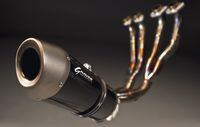In the process of evaluating one aftermarket product, we sometimes have to test a second piece of gear to complete the tuning recipe, even though that "other" item isn't the focus of our evaluation. This was the case with a Graves Motorsports exhaust system we installed on a 2009 Suzuki GSX-R1000 for the explicit purpose of reviewing Dynojet's Auto Tune Wideband O2 Controller (CW, April).
We chose the Graves exhaust for two reasons: 1) The diameter and thread pitch of Dynojet's Bosch O2 sensor were not compatible with the bung on the stock exhaust but matched the one on the Graves system; and 2) Dynojet had no map for the Graves pipe, which allowed us to determine that yes, the Auto Tune was a viable alternative to spending hours of costly dyno-tuning time to create a custom map for the GSX-R.
Styling is subjective, but to our eyes, the GSX-R's stock twin-muffler exhaust is no thing of beauty. And while lightweight for an original-equipment system, it still weighed 29.4 pounds on our certified scale. The Graves system, with its clean, low-mount MotoGP styling, consists of billet aluminum exhaust flanges, mandrel-bent stainless steel (add $282 for titanium) headers and a carbon-fiber canister, and it tipped the scale at just 9.6 pounds.
Installation was straightforward with one exception: Like all aftermarket systems, the Graves pipe eliminates the GSX-R's stock, servo-controlled exhaust valve. When the bike's electronic brain detected that the valve was missing, the "FI" error light on the dash illuminated and the odometer and tripmeter stopped working. The fix was as simple as fitting a $26 Two Brothers Servo Stop Bracket (part #005-125-05-01; www.twobros.com). So modified, the servo indexed properly when the ignition was switched on, preventing the error even in the absence of the actual valve. Graves has since produced its own bracket, which now comes with the pipe.
If you enjoy a throaty growl at idle and a piercing wail through the upper rev range, you are in for a treat. But it wasn't all just sound; there was fury, too. With the stock exhaust, the big Gixxer made 158 horsepower at 11,600 rpm. With the engine exhaling through the Graves pipe, peak output leapt to 165 hp at 12,500 rpm; nearer redline, the difference between the two systems was a whopping 12 hp.
The trade-off was lower-rpm power loss--as much as 7 foot-pounds of torque at 5000 rpm. While this dip didn't introduce any significant rideability issues, it's indicative of the differences between an aftermarket pipe developed for racetrack use with peak horsepower as its goal, as opposed to a stock exhaust with more linear delivery and government-mandated emissions levels as its priorities.
The power and sound characteristics of the Graves system make it loud and clear that this pipe is better-suited to track-day use than for daily duty. Is it the right exhaust for you? Let your ears and conscience be the judge.












/cloudfront-us-east-1.images.arcpublishing.com/octane/UWTN4NTIJFD25MPXBOVS4DFOXE.jpg)
/cloudfront-us-east-1.images.arcpublishing.com/octane/SIFOY54XMFGEHAUYNFUYVW7IZ4.jpg)
/cloudfront-us-east-1.images.arcpublishing.com/octane/HMC5X3JZHRASXGVCVNBJBWWGSI.jpg)
/cloudfront-us-east-1.images.arcpublishing.com/octane/UIWGXRZDM5HZXJOWXET2DZIWJE.jpg)
/cloudfront-us-east-1.images.arcpublishing.com/octane/QSS5DZ6SKJEU3AKE4KDAWYBEFY.jpg)
/cloudfront-us-east-1.images.arcpublishing.com/octane/SMCEQCLWRVEFTJJES6TAHB3OOQ.jpg)
/cloudfront-us-east-1.images.arcpublishing.com/octane/JCACIDCAC5FUNPTXO2BOUHGGII.jpg)
/cloudfront-us-east-1.images.arcpublishing.com/octane/DC7ZGILA2BCJXHZIUNYGV7JSEA.jpg)
/cloudfront-us-east-1.images.arcpublishing.com/octane/EWJEZUGWEZGABDEQWB64WL46GQ.jpg)
/cloudfront-us-east-1.images.arcpublishing.com/octane/5NHBMRMSFVD5JAPFNMBMNPGXQE.jpg)
/cloudfront-us-east-1.images.arcpublishing.com/octane/WHE43SCPLJBRNANAJAGXHOAIEU.jpg)
/cloudfront-us-east-1.images.arcpublishing.com/octane/6R56AQAW6NDE7BBIJ3SMCOOY5A.jpg)
/cloudfront-us-east-1.images.arcpublishing.com/octane/JMQTUE2FKZFURJTJXDMM4V47AQ.jpg)
/cloudfront-us-east-1.images.arcpublishing.com/octane/P2QYJDMQNVEANMQFXHNB3OVFKQ.jpg)
/cloudfront-us-east-1.images.arcpublishing.com/octane/VNKGXM4AA5BPRGERJOPV6GADAQ.jpg)
/cloudfront-us-east-1.images.arcpublishing.com/octane/2WS4YIFLTNG25L25WP7ZFLSWJM.jpg)
/cloudfront-us-east-1.images.arcpublishing.com/octane/UXRS6ZVQZFC23FY2EDYNT5WMVA.jpg)
/cloudfront-us-east-1.images.arcpublishing.com/octane/7JETMCKNVRGDZIGB3JCITGLPUU.jpg)
/cloudfront-us-east-1.images.arcpublishing.com/octane/OZV6E2KNIJDVHGOKXQQ2AHKLHQ.jpg)
/cloudfront-us-east-1.images.arcpublishing.com/octane/XSKMIBFZIZDN7JC6P7SMNMD3QA.jpg)
/cloudfront-us-east-1.images.arcpublishing.com/octane/ITVHWHVQ75BQBHACERYDJLPLHE.jpg)
/cloudfront-us-east-1.images.arcpublishing.com/octane/M3QRBSQ4VFEVPKYTTM3OETVFBU.jpg)
/cloudfront-us-east-1.images.arcpublishing.com/octane/H3EMT5NJ5BDZPBBH27SW3ADQH4.jpg)
/cloudfront-us-east-1.images.arcpublishing.com/octane/XTROSHDZFJB5DIJYU2VF2REFIU.jpg)